Tagged file managers. Comparative review

Where was this damn picture ?! I ran across her a hundred times until she was needed!
The organization of documents, familiar to us, into folders, the logic of which we got from the pre-digital era, still works great today when you need to distribute many files of the same type in an intuitive way.
But composing, for example, a collection of diverse, dissimilar images, you quite quickly come to a situation where there are five heels for the next file and sections that are suitable for it, but you, reluctantly, put it in the sixth file (vaguely feeling that month you will turn all these folders upside down, because you will surely forget which one you put it in).
')
A real salvation in this case is the transition to navigation by tags (labels, labels, themes, keywords - these terms differ from one application to another and overlap). Folders and tags correspond approximately as a table of contents and a subject index of the book: when information on one topic is scattered in different chapters, the list of pages with its references will be more useful than tedious browsing on a table of contents.
Yes, making a dozen (and sometimes not one!) Tags for a file is harder than dragging it from one daddy to another, but it pays off a lot when you can easily find a photo saved five years ago that only the Beautiful yellow dandelion in the corner in the background.
What convenience does the most well-known tag file manager offer us?
Disclaimer-intro
Those who want to quickly glance through the concise tablet with comparisons, can find it at the very bottom of the post. However, similar advantages and disadvantages of different programs are not always equivalent, which will be discussed in detail below. In the review there are both general managers and managers focused on media content, and the description goes from the first to the second.
I can not say that I thoroughly figured out the nuances of each application, and some details must have escaped my attention. I invite you to correct me if you find inaccuracy somewhere in the description. I explain all the unobvious comparison criteria as they appear in a particular program, but you can read their meaning in the small glossary below.
Glossary
Grouping tags - the ability to split tags into sections to facilitate the search for the desired tag.
Tag hierarchy (inherited tags, implied tags) - automatically add X, Y tags when you add a Z tag.
Tag aliases (synonyms, fraternal tags) - the manager returns the same files for the X and Y tags, regardless of which one was entered.
Tag automation - tagging based on file characteristics (path, size, type, internal file metadata, etc.), especially when importing new files.
Logical operations with tags when searching: AND (returns files that match all tags in the search string) OR (returns files that match at least one tag in the search string) NOT (returns files that do not have this tag).
Virtual folders are filters that produce a fixed list of files assigned by the user (regardless of the tags or physical location on the disk).
Dynamic folders are filters that produce a list of files according to criteria assigned by a user (a set of tags, size or file type, etc.).
Grouping files - the ability to minimize some of the files when displayed in one object.
The file rating system - although the rating can be organized using ordinary tags, the dedicated service will always be more convenient.
Detection of duplicate files - identification of identical files by hash or other parameters.
Tag hierarchy (inherited tags, implied tags) - automatically add X, Y tags when you add a Z tag.
Tag aliases (synonyms, fraternal tags) - the manager returns the same files for the X and Y tags, regardless of which one was entered.
Tag automation - tagging based on file characteristics (path, size, type, internal file metadata, etc.), especially when importing new files.
Logical operations with tags when searching: AND (returns files that match all tags in the search string) OR (returns files that match at least one tag in the search string) NOT (returns files that do not have this tag).
Virtual folders are filters that produce a fixed list of files assigned by the user (regardless of the tags or physical location on the disk).
Dynamic folders are filters that produce a list of files according to criteria assigned by a user (a set of tags, size or file type, etc.).
Grouping files - the ability to minimize some of the files when displayed in one object.
The file rating system - although the rating can be organized using ordinary tags, the dedicated service will always be more convenient.
Detection of duplicate files - identification of identical files by hash or other parameters.
General File Managers

1. TagSpaces
( www.tagspaces.org )License: freemium (limited features in the free version)
Platforms: Windows, Mac, Linux
Tag storage method: file name (in the Pro version you can write tags in side files)
Tag grouping: yes (colors, categories)
Tag hierarchy: none
Tagged aliases: none
Tag automation: partial (smart tags)
Logical operations with tags when searching: AND, NOT
Search history tags: partially (available in the Pro version)
Tag sharing online: none
File storage method: file system
Virtual folders: none
Dynamic folders: none
File grouping: none
File rating system: partially (5 stars as regular tags)
Duplicate file detection: missing
Built-in file viewer: yes (sidebar, text viewer)
Built-in basket: partially (available in the Pro version)
Notes for files: partially (available in the Pro version)
Fixing URL file sources: absent
Loss of metadata in case of abnormal file transfer: none (metadata is stored in the file name / in the side file)
Killer features: geotagging, text viewer / editor

TagSpaces appears in the search one of the first, when you take to look for something on this topic. Keeping tags in the free version is implemented directly in the file name by the mask filename [tag1 tag2 tag3], which gives its pros and cons. These tags can be used by third-party programs, including your regular file manager, they are always visible, will not disappear after the application is deleted, and they can be edited without even opening the program itself. There are also obvious limitations: you cannot use tags with spaces (in fact, you can, the separator symbol changes in the settings, but keep in mind that when you change it, the previously made tags will break), and for detailed tagging, consider the limitations associated with the long file name on your system.
TagSpaces rises on top of the existing folder system and allows you to store a set of links to the most running folders in the drop-down menu in the upper left corner of the window. If you are used to using the basket, then you should not delete files directly from the free version of the program: it deletes files past the OS basket.
The highlight of the program are smart tags that convert to the desired date or geotag when using them. In addition, there is a fairly rare image viewer and PDF-files and simple text files (the latter can even be edited directly from it).

2. Tagz
( sourcesmithy.com )License: paid (trial version for 20 files)
Platforms: Windows, Mac
Tag storage method: file name
Tag grouping: none
Tag hierarchy: none
Tagged aliases: none
Tag automation: none
Logical operations with tags when searching: not set
Tag Search History: none
Tag sharing online: none
File storage method: file system
Virtual folders: yes (file lists)
Dynamic folders: none
File grouping: none
File rating system: none
Duplicate file detection: missing
Built-in file viewer: no
Built-in basket: no
Notes for files: absent
Fixing URL file sources: absent
Loss of metadata during abnormal file transfer: none (metadata is stored in the file name)
Killer feature: file lists

According to the author, the program is designed in a concise Uinx-philosophy of performing one function. But it is no exaggeration to say that the program is too laconic. From the settings, only the choice of the separator symbol and limit characters.
Tags are not divided into groups and are not highlighted in color, sitting in an array in the panel at the bottom of the window. Any change to the tags is accompanied by an obtrusive, non-switchable “Operation successfull” window, and each time you have to click OK. The program forgets an open folder or file list, and when you open it, each time you will see an empty window. In the file name, it is not allowed to use tilde, comma, minus and other symbols that can be used by the program as a separator (except for the separator symbol that is currently selected). Otherwise, the program will not be able to parse its own tags.
It was not possible to enjoy the search capabilities, since he searched for the extra-tagged file name even in Tags mode.
The main advantage is the ability to save and open arbitrary lists of files stored in files without an extension. I would have looked at people who paid $ 20 for the license of this program.

3. Tabbles
( tabbles.net )License: freemium (up to 5000 files in the free version)
Platforms: Windows
Method of storing tags: the internal database of the program
Tag grouping: yes (nested tags, color)
Tag hierarchy: none
Tagged aliases: none
Tag automation: yes (up to 15 rules in the free version)
Logical operations with tags when searching: OR, NOT
Tag search history: yes
Sharing tags on the network: there is (up to 90 days in the free version)
File storage method: file system
Virtual folders: none
Dynamic folders: none
File grouping: none
File rating system: none
Duplicate file detection: missing
Built-in file viewer: yes (sidebar, separate window)
Built-in basket: no
Notes for files: yes (user comments, up to 5000 commented files in the free version)
Fixing URL file sources: absent
Loss of metadata in case of abnormal file transfer: none (smart file tracking) (you can link the file again if there was no renaming)
Killer features: smart file tracking, integration with Explorer, tagging of Internet bookmarks, integration with Outlook (up to 100 letters in the free version), inter-user notes, comments
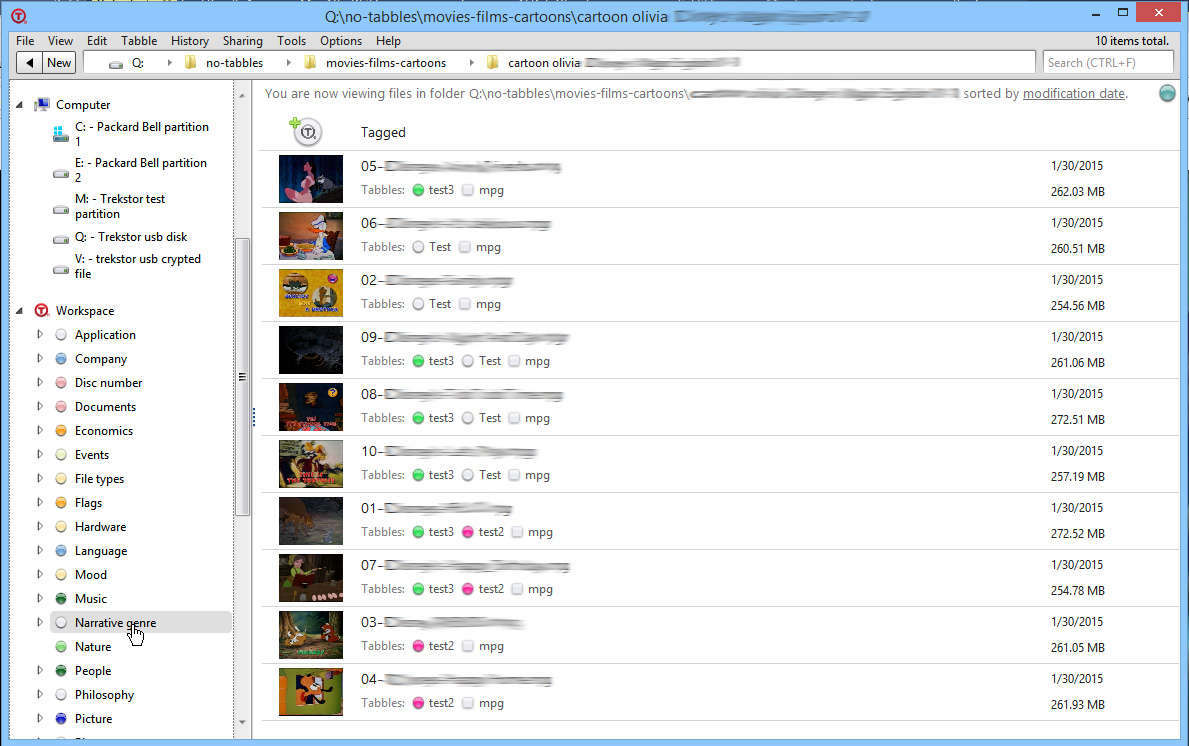
Tabbles was created with a strong bias in group tag editing. Built-in features allow you to synchronize tags on devices of one user (for a fee, advanced version), and across network drives / clouds among an unlimited number of users (for a fee, corporate version). The synchronization of each tag can be managed individually. Each file is accompanied by a chain of comments that corporate users can read and leave.
A unique algorithm tracks moving, renaming and modifying a file without having to reattach it. You will need to disable the program and turn the file strongly so that the program does not recognize it when you start it again, but it is possible.
Tabbles is tightly integrated with Explorer. Icons of tagged files are marked in Windows Explorer with a special overlay to distinguish them from files without tags. The application monitors the open folders in real time, offering to edit the tags of new and changed files using pop-up interactive notifications in the corner of the screen.

A lot of time and nerves can be saved by a powerful automatic tagging system, which allows you to assign tags depending on the folder, name mask, file type, file contents, regexp, or an arbitrary combination of them. You can open many windows with different tag combinations, and with a simple drag and drop, all tags of the combination that is open in a particular window will be assigned to files.

4. Elyse
( silkwoodsoftware.com )License: freemium (up to 30 tags in the free version)
Platforms: Windows, Mac
Method of storing tags: the internal database of the program
Tag grouping: yes
Tag hierarchy: yes
Tagged aliases: none
Tag automation: yes (by folder)
Logical operations with tags when searching: AND, NOT
Tag Search History: none
Sharing tags online: yes
File storage method: file system, program internal database
Virtual folders: none
Dynamic folders: yes
File grouping: none
File rating system: none
Detection of duplicate files: yes
Built-in file viewer: yes (separate window)
Built-in basket: no
Notes for files: none
Fixing URL file sources: absent
Loss of metadata in case of abnormal file transfer: partially (you can link the file again if there was no renaming)
Killer feature: A combination of physical files and tags on the same tree.

Unlike previous managers, Elyse allows us to combine the grouping of tags by tabs and the tag hierarchy in a separate Tag Relationships window. In the hierarchy of tags, tags are divided into older and younger ones, and when one of the younger tags is entered, all older tags are added to the description automatically. For example, it is not necessary to introduce one another “animal”, “reptile” and “crocodile”. Enough to make a "crocodile", and both older tags will be added themselves.
In addition, the application supports two modes of introducing new files: embedding into internal databases-directories with the .ely extension, or a simple binding with preserving the original location (icons of such files are marked with an overlay with an arrow, like shortcuts in a regular Explorer, what they are, in essence, and are). Choosing the method of binding, you should be careful about moving files outside of Elyse: the application is not able to track and recognize the files being moved as easily, but even in this case it will not be difficult to reattach them. In embed mode, Elyse prevents the addition of a duplicate if the original is already in the database, as warned in the warning window.
Browsing Tree tab can search for any tags in logical combinations AND, NOT. But, unlike the usual search by tags, these combinations are stable and are always available with one click (forming the so-called “dynamic folders”, that is, folders with contents that change depending on the content of the catalog base). In the usual tags in Browsing Tree, you can mix physical folders on the disk and filter their contents using tags, and the same folder can be connected several times with different tags.
Tag automation in Elyse comes down to the ability to add folder names as tags when importing a file. You can control how many levels of folders will be used to create tags, which is convenient.

5. FenrirFS
( www.fenrir-inc.com/us/fenrirfs/ )License: free
Platforms: Windows
Method of storing tags: the internal database of the program
Tag grouping: yes (colors, categories)
Tag hierarchy: none
Tagged aliases: none
Tag automation: yes (by name mask, by extension mask, by regexp, by size range, by date range)
Logical operations with tags when searching: AND, OR
Tag Search History: none
Tag sharing online: none
File storage method: file system, program internal database
Virtual folders: none
Dynamic folders: yes
File grouping: none
File rating system: yes (star)
Duplicate file detection: missing
Built-in file viewer: yes (sidebar, text viewer, slideshow mode)
Built-in basket: yes
Notes for files: yes
Fixing URL file sources: absent
Loss of metadata due to abnormal file transfer: partially (you can link the file again)
Killer feature: integration with Evernote, Facebook, Tweeter.

The application gives a bit more freedom in creating nested tag categories, but the hierarchy, unfortunately, is not supported. But next to each tag is set the counter associated files. There is a dedicated rating system - files can be marked with a star. Built-in recycle bin supports reversible deletion while preserving metadata and rating. As in TagSpaces, viewing pdf and text files is supported, but for editing you will have to open a third-party editor.
You can connect physical folders as profiles, but between different profiles, tags will not work (this can be bypassed by creating subfolders in the profile folder, whose names will by default be added as tags to the files in them). Like Tabbles, an application monitors its folders by adding new files on the fly, but unlike Tabbles and Elyse, a lost file can be linked again, even if it has been renamed, or you can attach another file altogether.
In addition to connecting folders, the database mode is also supported: documents will be stored in a special program folder in open form. Because of this, conflicts arise with the same file names, and, unfortunately, duplicate file detection is not implemented.
Dynamic folders filter files by type, tags, dates and other parameters: the filter script can be written directly in the folder properties, but you will need to know the syntax: gui for setting the folder is not provided.
The application will greatly facilitate your life if you often post images on Facebook or Tweeter or use Evernote.

6. TaggedFrog
( lunarfrog.com/projects/taggedfrog )License: free
Platforms: Windows
Method of storing tags: the internal database of the program
Tag grouping: yes (favorites)
Tag hierarchy: none
Tagged aliases: none
Tag automation: yes (by folder, by name mask, by extension mask)
Logical operations with tags when searching: AND, OR
Tag Search History: none
Tag sharing online: none
File storage method: file system
Virtual folders: none
Dynamic folders: yes
File grouping: none
File rating system: none
Duplicate file detection: missing
Built-in file view: absent
Built - in basket: absent
Notes to files: absent
Fixing URL file sources: absent
Metadata loss during abnormal file transfer: partial (you can link a file again)
Killer feature: Tag cloud

The layout of the application is as simple as possible: there is a tag cloud above, where the font size of the tag changes depending on the frequency of use (you can also adjust the dependency on the number of files), below there is a filter by tags and file types, and at the bottom - the files themselves. At the bottom left, the tags of the selected file are displayed; above, dynamic folders by file type and filters / tag groups (Favorites).
In the presence of a simple algorithmization of tags when importing files and a tag editor. As in FenrirFS, you can link a lost file after renaming or moving it.

6.5. Xyplorer
( alternativeto.net/outgoing/software/xyplorer )License: paid (full version for 30 days)
Platforms: Windows
Method of storing tags: internal database of the program
Tag grouping: no
Tag hierarchy: no
Tag alias: no
tag Automation: no
Logical operations with tags when searching: And
Search history of tags: none
Share tags over the network: no
File storage method: file system
Virtual folders: none
Dynamic folders: none
File grouping: absent
File rating system: yes (color)
Duplicate file detection: absent
Built - in file browsing: yes (sidebar, text viewer)
Built-in recycle bin: absent
Notes to files: absent
Fixing URL file sources: absent
Metadata loss during abnormal Moving files: yes
Killer feature: converting plain text into tags when pasting
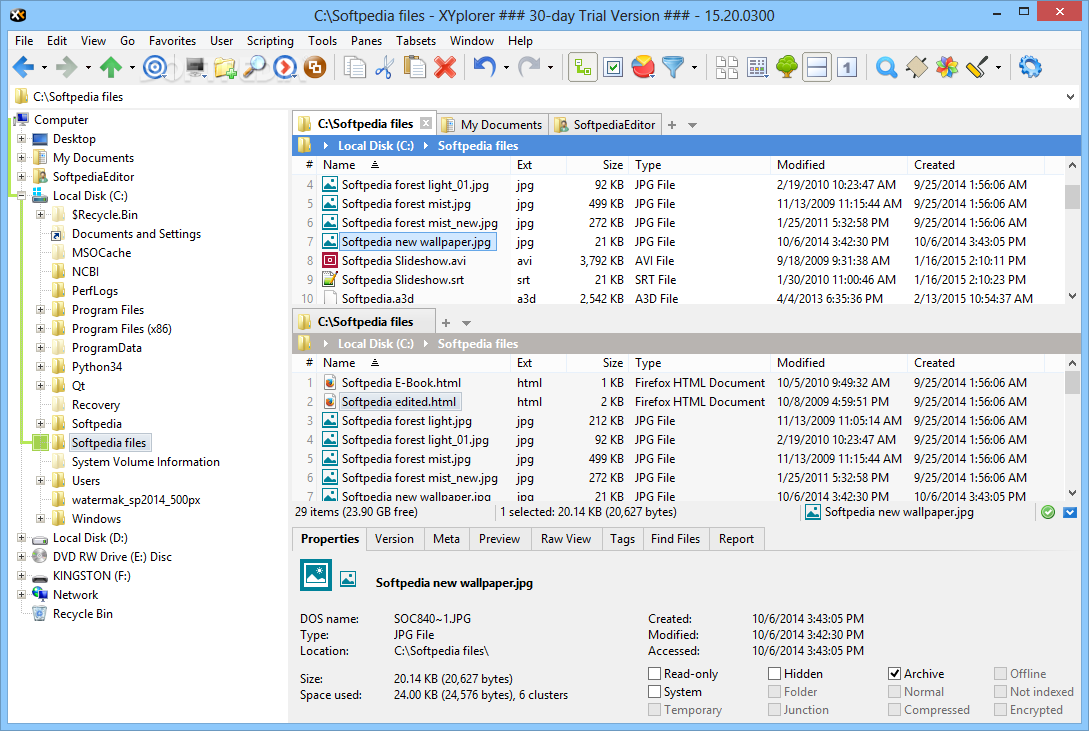
Let the tags are not the main advantage of this multifaceted manager, he still found something to stand out even among specialized software. XYplorer allows you to copy a line of text from the same Notepad, immediately add it as a set of tags to existing ones or paste them with the replacement of previous tags. Against the background of the program’s other features, which make the interface more similar to the aircraft’s dashboard, XYplorer can be quite a tolerable compromise between tags and folders, provided that your tagging system remains as simple as possible.
File managers for media content

1. JetPhoto Studio
( www.jetphotosoft.com )License: freemium (in the free version, auto-convert images to jpg, no video support, RAW)
Platforms: Windows, Mac
Method for storing tags: internal database of the program
Tag grouping: none
Tagging hierarchy: none
Tagging alias: none
Tag automation: none
Logical operations with tags during the search: none
Tag search history: none
Tagging over the network: absent
File storage method: internal program database
Virtual folders:none
Dynamic folders: none
File grouping: no
File rating system: yes (star)
Duplicate file detection: no
Built - in file browsing: yes (magnifying mode, slideshow mode)
Built-in recycle bin: absent
Notes to files: yes
Fixing URL source files: there is
loss abnormal metadata when moving files: partially (left previews and metadata associated file can not be re)
Killer features: geo-tags, cover, calendar integration with Flickr, publish web galleries
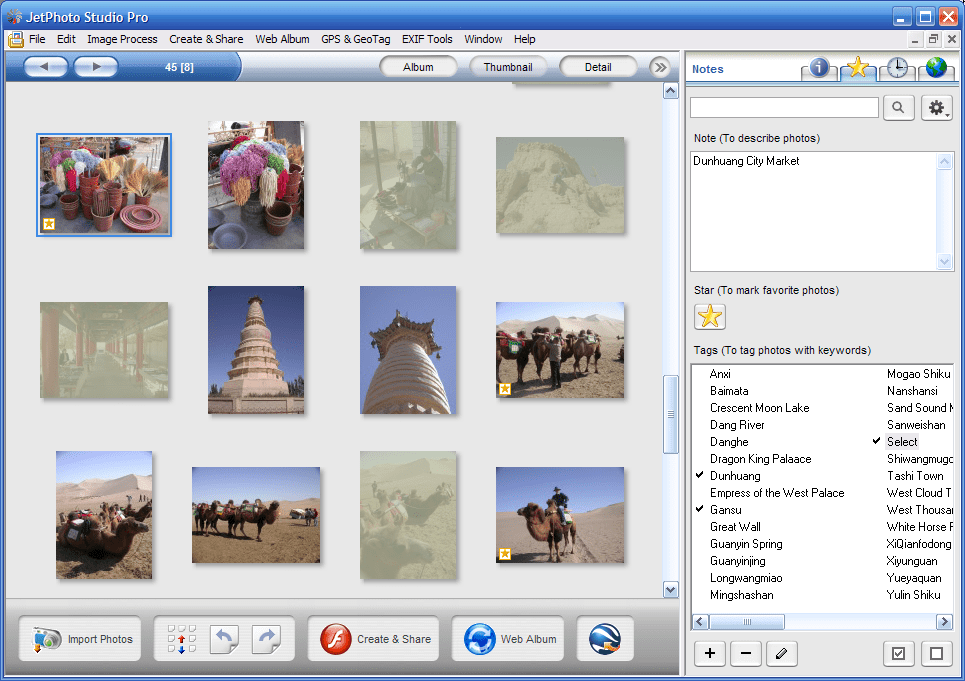
Manager of photo albums with a rich set of whistles. Using the free version does not seem practical, since all your PNGs and GIFs will be converted with loss of quality and animation. There are basic editing tools like crop, contrast and color balance spins, B & W and Sepia. In the presence of the wizard to create wallpapers, mobile wallpapers, galleries on flash, web galleries, screensavers, setting geo-tags with reference to Google Earth, editing exif. The visual calendar calendar with the dates of creating photos has been implemented.
Tag management is in a rudimentary form, but there is a star rating and a dedicated storage of the file source URL (unfortunately, only one URL).

2. XnView
( www.xnview.com )License: freeware (for personal use)
Platforms: Windows
Tag storage method: program internal database
Tag grouping: yes
Tag hierarchy: none
Tagging aliases: none
Tag automation: none
Logical operations with tags when searching: OR
Tag search history: absent
Network tag sharing: absent
File storage method: file system
Virtual folders: absent
Dynamic folders: partial (file type filters)
File grouping: partially (temporary notes)
File rating system: yes (5 stars, 5 colors)
Duplicate file detection: partially (there is a manual duplicate search)
Built-in file viewer: yes (sidebar, full-screen mode, slideshow mode, text viewer)
Built-in Recycle Bin: None
Notes to Files: None
Fixing URL-source files: None
Loss of metadata during abnormal movement of files: partially (save when moving, loss when renaming)
Killer feature: search for similar images

The popular viewer also has built-in cataloging capabilities that are respectable even against the backdrop of paid applications. Multi-level tagging, ratings, colors, and adding physical folders to Favorites already allow you to manage your media collection at an acceptable level (non-media tagging is not supported).
You can also move files from the regular Explorer, but you should rename it inside the program in order not to lose the tags and ratings - you will not be able to link them again.
The lack of file grouping is partially overlapped by the timestamp service — files with this tag can be filtered separately. But it should be borne in mind that restarting the program labels will not survive.

3. Adobe Bridge
( www.adobe.com/products/bridge )License: paid (delivered free of charge with other Adobe products)
Platforms: Windows, Mac
Method of storing tags: file metadata, hidden file for each folder
Tag grouping: yes
Tag hierarchy: yes
Aliases tags: none
Tag automation: partly
Logical operations with tags when searching: AND, OR, NOT
Tag search history: partially (last query structure is saved)
Tag sharing over network: none
File storage method: file system
Virtual folders:have
dynamic folder: there
Grouping files: there are
files Rankings: there are (5 stars, 5 colors)
Identify duplicate files: no
built-in File Browser: there (sidebar, full screen mode, magnifying glass mode, slideshow mode)
Built-in shopping cart: partly ( rejected files)
Notes for files: yes (file metadata)
Fixing URL sources of files: yes (file metadata)
Loss of metadata due to abnormal file movement: partially(metadata embedded in files is saved, data is hidden in hidden files)
Killer feature: not detected
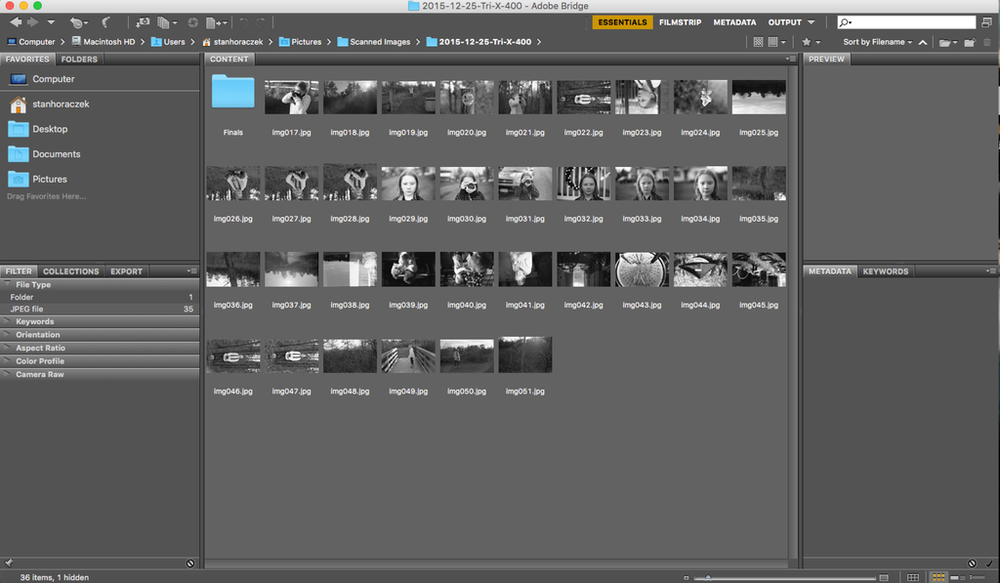
Bridge was created as a media browser that bundles the Adobe ecosystem together, and therefore can generate high-quality previews for almost all proprietary Adobe formats: including pfd documents, Photoshop files, Illustrator files, and even exotic things like previews of video projects, layout files and so on. There are previews of raw files from different manufacturers.
Although Bridge recognizes any kind of files, it can only add tags to files that support metadata, which greatly narrows its scope, but otherwise its capabilities are impressive: in addition to grouping, hierarchy, and tag searching in any combinations, Bridge will allow you to store arbitrary combinations of files in virtual folders (Collections), and also supports dynamic folders (Smart Collections). In the cluttered folders, the grouping of arbitrary files in collapsing spoiler stack helps. For rating files there are 5 stars and 5 customizable colors.
Tagging automation is limited: you can create sets of tags, but you have to manually apply them. Although storing notes and URLs is also implemented in metadata, editing and viewing them individually through File Info is very problematic.

4. Adobe Photoshop Lightroom
( www.adobe.com/products/photoshop-lightroom )License: paid (full version for 30 days)
Platforms: Windows, Mac
Way of storing tags: internal database of the program
Tag grouping: yes
Tag hierarchy: yes
Tag Alias: yes
Automation of tags : there are
logical operations with tags during the search: AND, OR, NOT
Search history of tags: absent
Network tag sharing: absent
File storage method: file system, internal program database
Virtual folders: yes
Dynamic folders: yes
File grouping: yes
File rating system: yes (5 stars + customizable color sets)
Duplicate file detection: yes
Built-in file browsing: yes (sidebar, full-screen mode, magnifying mode, slideshow mode)
Built-in basket: partially (discarded files)
Notes for files: yes (file metadata)
Fixing file URLs: yes (file metadata)
Loss of metadata due to abnormal file movement: partially (previews and metadata remain, you can link the file again)
Killer features: contextual tag prompts, tag sets, integration with Facebook, Flickr, Behance and other services

Lightroom's cataloging capabilities are very lethal, and not from scratch. The program allows you to fulfill almost any dream of even the most demanding organizing freak. In addition to the many functions found in other programs, Lightroom is one of the few that supports key aliases (key word synonyms), when the program treats two different tags as one and the same, returning the same files when searching. The rating of five stars is combined with sets of colors that can be switched on the go, and the ability to reject files serves as a substitute trash bin. Lightroom analyzes the dynamics of tag usage and displays the most context-appropriate tags in the keyword suggestions panel, and tag sets allow you to switch among dozens of tags in a few clicks.
But professionalism leaves its mark: the program accepts an extremely limited range of files - even gif-files cannot be imported.
The same problems with editing notes and URL sources as for Bridge do not have a separate panel for them, and you will have to constantly crawl into the wilds of the Metadata panel.
The ability to automate imports was unexpectedly modest - you can select only one folder, configure the rename method, select the list of tags and preset metadata. And the flexibility that Tabbles or FenrirFS gives is not observed at all. The search is just as primitive as compared to Bridge, in which it is allowed to wind up multistage search criteria.

5. Hydrus Network
( hydrusnetwork.imtqy.com )License: free
Platforms: Windows, Mac, Linux
Method of storing tags: internal database of the program
Tag grouping: yes
Tag hierarchy: yes
Tagging alias: yes
Tag automation: yes (by folder, by name mask, by file type, regexp, file size, image height / width)
Logical operations with tags when searching: AND, NOT
Tag search history: yes
Network tag sharing: yes
File storage method: internal program database
Virtual folders: none
Dynamic folders: partially (tabs)
File grouping: yes
File rating system: yes
Duplicate file detection: yes
Built-in file viewer: yes (sidebar, full-screen mode, slideshow mode)
Built-in basket: yes
Notes to files: yes
URL-source fixing files: there is a
loss of metadata in case of abnormal file transfer: yes
Killer features: automate downloading images from any site, parsing tags from any site, P2P tag exchange, tabs, hiding tags, customizing the rating, searching for similar images

The creation of this application was strongly influenced by the order of placing data on booru-like sites. First of all, it is a means of archiving data. After the file is entered into the database, no change or movement is meant: its name is changed to a hash, and it is placed in accordance with the internal logic of the program database (valuable information from the name and path of the file can be extracted during import using regexps).
The list of acceptable formats is a bit more diverse than Lightroom’s: bmp, gif, png, jpg, mp3, ogg, flac, webm, flv, mp4, wmv, swf and pdf.
The application has its own full-fledged basket with a customizable capacity and the duration of storage of deleted files. There is a built-in search engine for similar images.
Hydrus uses color-coded namespaces to group tags. It does not contain dynamic folders, but this is partially compensated by the presence of tabs, each of which may contain an individual query. Tabs are saved when you close and reopen each time you start the program. Replace virtual folders, unfortunately, nothing.
Instead of grouping, Hydrus applies a rather cunning tag system nested in namespaces. For example, files with tags page: 1, page: 2, etc. grouped together by chapter: 1, files with chapter: 1, chapter: 2 tags are grouped together by book: some_random_name, and so on. Attachment hierarchies can be managed, although in general the system is quite rigid and labor-intensive when editing.
Of particular note is a fully customizable rating system. You can create any number of like / dislike ratings or digital ratings with any number of points that will be operated and managed independently of each other, and if you want to convert a 5-point system into a 100-point system, the ratings that have already been entered are automatically recalculated with the proportions .
Hydrus has downloadable tag repositories. If the image has already been tagged by someone, after updating the repository, you will automatically receive the corresponding tags. You can also deploy your own repository or commit your own tags to a common database.
If tags are downloaded from a third-party site, then (with your confirmation) they commit automatically. Out of the box there is support for downloading tags and images from a number of popular sites like deviantart, tumblr, pixiv and others, and for less popular ones, you can find a third-party script.

6. ACDSee Photo Studio
( Www.acdsee.com )License: Paid (full version for 31 days)
Platforms: Windows, Mac
The method of retention tags: file system, internal database program
grouping tags: there is
hierarchy of tags: there
aliases tags: places without
Automation of tags: there
Logic operations with tags during the search: AND, OR
Tag search history: yes
Tag sharing over the network: absent
File storage mode: internal program database
Virtual folders: yes
Dynamic folders: yes
File grouping:there is a
file rating system: yes (5 stars + customizable color sets)
Duplicate file detection: partial (there is a manual duplicate search)
Built-in file viewer: yes (sidebar, full-screen mode, slideshow mode)
Built-in basket: partially (Image basket)
Notes for files: yes (file metadata)
FixingfileURLs: yes (file metadata)
Loss of metadata due to abnormal file movement: yes
Killer features: Categorizing images, searching for similar images
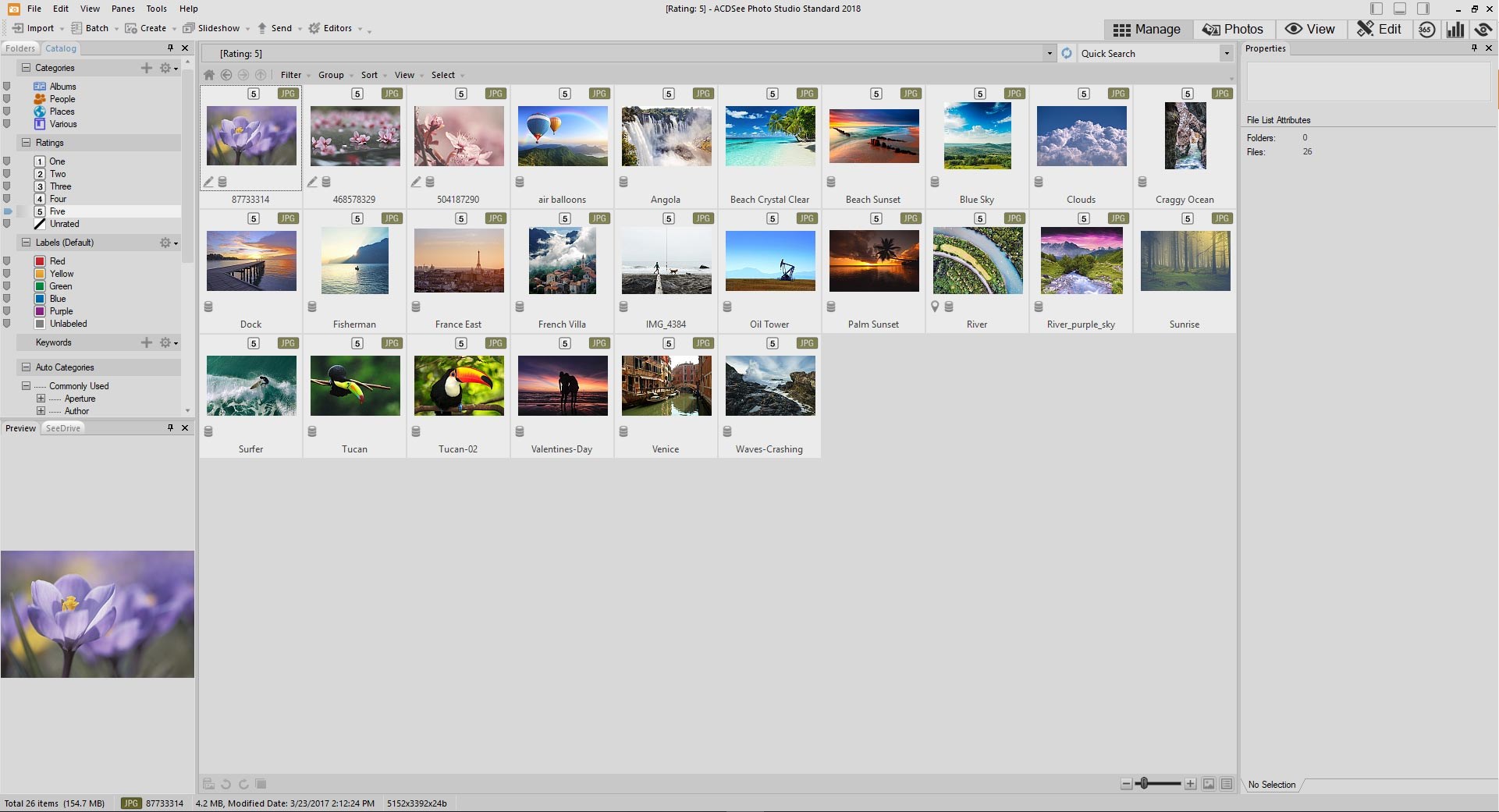
The logic of working with metadata is largely borrowed from Lightroom. There are no tags for tags, but there is a dedicated file sharing service by category. Technically, it is no different from simple tags, but its isolation provides an additional level of organizational freedom. Arbitrary file grouping is not provided, but there is a grouping by parameters, as in Windows Explorer.
ACDSee Photo Studio allows the addition and tagging of any files, which is rare among programs of this class, but the description and URL, as is the case with Adobe products, is allowed only in files with metadata support. Metadata is moved to a separate tab, which makes viewing and editing a bit easier compared to Lightroom.
With the search and import of the case, too, are more rosy. Several custom profiles for import are supported, the search supports many criteria and even is able to save their configurations, but for some reason negative search conditions are not implemented.
The surprise was not to detect the ability to set tags for aliases. Perhaps they are cleverly hidden somewhere in the gut of settings, but I could not get to them.
Analogue of the Literum Quick Collection is the Image Basket service. In part, it can be used as a basket, but you can only place media files in it and you cannot configure automatic deletion, as in Hydrus.
Move files within the file system should only be through the application, otherwise the information entered will be lost without the proposal to re-link the file.
Conclusion
I hope my analysis has helped you decide on the choice of tag manager for your needs. If you use any other solution, share your experience in the comments. Here is a brief comparative table:

Source: https://habr.com/ru/post/374465/
All Articles